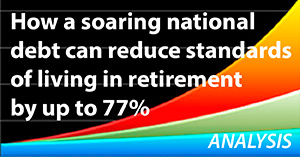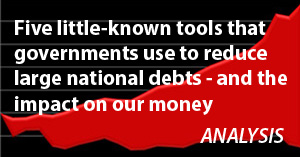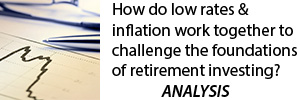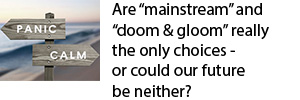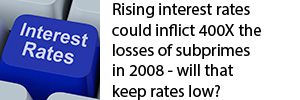Mice, Mazes & Investor Perception Management
by Daniel R. Amerman, CFA
Confidence in retirement investing is once again soaring among the general public. According to a recent survey, those who own retirement accounts are feeling almost twice as confident about their ability to retire and what their standard of living will be in retirement than they were two years ago.
At the same time, a well known and highly sophisticated investment executive has recently semi-retired at age 56. And now that this Oxford economics PhD is managing his own retirement portfolio instead of being CEO of one of the largest investment companies in the world, he isn't buying stocks, he isn't buying bonds – and indeed he is running away from conventional retirement investments as fast as he can.
Now where things get really interesting and also ironic is that the source of the general public's newfound optimism is the same factor that is driving this economics expert to take his own money and run – that being record stock market prices. The extreme contrast comes down to the degree of understanding about why prices for stocks and bonds have moved so high. It's not what the public thinks it is, and for those on the inside and in the know, it is why they're running.
Public Confidence Surges
The results of the 25th annual Retirement Confidence Survey were recently released. Conducted by the Employment Benefit Research Institute (EBRI), the study showed that over the last two years there has been a dramatic change in attitudes for both current workers and current retirees. Highlights include:
The percentage of current workers with retirement plans who are confident they will have a comfortable retirement has increased from 14% in 2013 to 28% in 2015.
The percentage of current retirees who are very confident their retirement will be financially secure has increased from 18% in 2013 to 37% in 2015.
There has been very little if any change in confidence among those who do not have retirement accounts.
The increased confidence is not coming from saving more, because most people aren't.
Rather, one of the co-authors attributes the dramatic gain in confidence to statistics showing that 401(k) plans increased in value in a range from 19% to 47% in the single year of 2014.
In other words, the dramatic surge in retirement confidence seems to be almost entirely linked to investors who own stocks in their retirement accounts, and who are feeling really, really good about the strong results produced by those investments in recent years.
A Starkly Contrasting Perspective
Dr. Mohamed El-Erian is the former CEO of Pacific Investment Management Co (better known as PIMCO), the very well known $1.7 trillion investment firm, and he recently gave an interview with his local newspaper, the Orange County Register (link here). While the interview covered many topics, his answers to a few key questions were particularly notable:
Q. Where is your money? Stocks? Treasuries? Bonds?
A. It is mostly concentrated in cash. That’s not great, given that it gets eaten up by inflation. But I think most asset prices have been pushed by central banks to very elevated levels.
Q. So we’re nearing a bubble?
A. Go back to central banks. Central banks look at growth, at employment, at wages. They are too low. They don’t have the instruments they need, but they feel obliged to do something. So they artificially lift asset prices by maintaining zero interest rates and by using their balance sheet to buy assets.
Why? Because they hope that they will trigger what’s called the wealth effect. That you will open your 401k, see it has gone up in price, and you’ll spend. And that companies will see their shares are going up and they will be more willing to invest. But there is a massive gap right now between asset prices and fundamentals.
And then there's the following:
Q. Why write a book on central banks?
A. This is a historic period in which central banks are the only game in town when it comes to policy. But central banks do not have the tools to deliver what the global economy needs. We need more potent reinvigorated growth models.
What El-Erian admitted in his newspaper interview was something fairly astounding from a financial expert's perspective. He said he was keeping his money in cash knowing full well that once inflation is taken into account he was going to incur losses by doing so.
Why on earth would a financial expert accept losing money on his own investments?
The answer, of course, is to avoid losing much more money elsewhere.
The Knowledge Gap & The Surreal Triangle
Having begun the formal study of finance and economics as an undergraduate in 1977, I've been immersed in these subjects for what is getting close to 40 years now. Over that time I have seen tremendous changes in the markets, from bull markets to bear markets, to bubbles forming, to bubbles popping, with great wealth being both created and lost – but I've never before seen anything like the current situation.
And what I mean by that is that I am seeing the greatest gap in my professional lifetime between what the general public understands about savings and investments, as opposed to the quite different understanding that is shared on a global basis among the people making policy decisions and running the major institutions.
To understand just how extraordinarily wide this gap has become, consider the three informational points below, each of which exist simultaneously, and each of which became public in April of 2015. Taken together, they form an almost surreal triangle of sorts, where almost nothing about investment reality is working the way that most people believe it does.
1) The US economy just strongly surprised to the downside again, growing at a paltry 0.2% pace in the first quarter – with no growth at all if we make any of several possible adjustments to that, such as removing the spectacular surge in inventories, or allowing for even a slightly higher real rate of inflation. It's a continuation of going on eight years of major underperformance by the economies in the US and other nations.
2) Simultaneously, confidence among retirees and retirement investors is soaring because their stock portfolios are performing so fantastically well.
3) An insider's insider, who also just happens to be the current chairman of President Obama's Global Development Council, just stated in a casual interview with his local newspaper:
"Central banks ... artificially lift asset prices by maintaining zero interest rates...
...Why? Because they hope that they will trigger what’s called the wealth effect. That you will open your 401k, see it has gone up in price, and you’ll spend...
...But there is a massive gap right now between asset prices and fundamentals."
In other words, the Federal Reserve is quite deliberately causing 401(k) balances to inflate far above what would be justified by current economic fundamentals, so as to change the behavior of conventional retirement investors.
And this intentionally-created illusion has been wildly successful (see #2 above).
Yet the goal for this manipulation, the reason for the illusions – which is essentially to boost economic growth – isn't working at all (see #1 above).
Mice In A Maze
To better understand the extraordinary disconnect between what the public is encouraged to believe and what is actually happening, using an analogy of laboratory mice in a maze may be helpful.
Changing investor behavior in order to achieve desirable outcomes is core to both macroeconomics theory and central banking policy. The theory is that by changing incentives, investor behavior can be changed in such a manner that supports stability and growth, thereby serving the greater societal good. These incentives can be positive or negative, and currently we've been seeing a lot of both.
In other words, the mice need to be made to move to a different place in the maze than they are right now. And if too many "mice" are in the low risk location of keeping their money in cash at the bank or in money market funds, which is not generating economic growth – then they need to be given the motivation to leave.
Zappp!
That's where the "electric shock" comes in. The scientists / central bankers pull down on the lever in order to get all of us mice jumping up in the air and moving around as we try to avoid the discomfort.
The electric shock is of course zero interest rate policies accompanied by somewhat higher rates of inflation, which means we steadily lose purchasing power. In other words, the officially stated policies of central banks around the world right now.
These very low interest rates actually serve multiple purposes for governments, four of which are in direct conflict with the interests of most investors – as explained in this article. Now they do also directly facilitate a rise in stock prices in multiple ways, including lower cost capital for investment (which leaves more money for equity owners), lower cost margin loans for investors buying stocks, and providing very cheap funding for the massive stock buyback programs (where corporations borrow money to buy their own stock).
But inflicting discomfort on investors is also a key objective. Because the theory is that too many people keeping their money in safe assets has a negative effect on economic growth, so the government and central banks aim to provide the strongest motivation possible to get people to move their money and to take the risks that are theorized to spur growth, and therefore investors seeking safe income are punished with negative returns (once the effects of inflation are accounted for).
So, the continuous administration of electric shocks thus force some of the mice out of their comfort zone, and they take risks which they would not otherwise take. And these millions of "mice" seeking out risky investments impacts the supply and demand for risky investments such as stocks and high yield bonds. Which predictably increases the prices of stocks, thereby producing profits for stock investors. And so it is that we have the appearance of big juicy profits in what is an otherwise yield-starved environment (as a matter of maze design).
In other words, the first cheese cube just materialized, and in exactly the place in the maze where the scientists want the mice to move.
Other mice that are getting tired of scurrying around trying to avoid the unrelenting electric shocks, notice that some cheese just appeared, and in a place where nobody is being shocked. So they run through the maze and buy some stocks, so they can enjoy their cheese too.
Their purchasing stocks further increases stock prices. Which produces more cheese. Which attracts still more mice. Until there is a great big pile of cheese in exactly the place where the scientists want the mice to be. Which in theory is supposed to create a veritable mouse stampede, as the mice flee the shock zone for the cheese.
What's another name for those piles of cheese? That would be the "wealth effect" that Dr. El-Erian referred to in his interview.
Now, one of the truly twisted things about economics, which can be very confusing for non-economists, is the relationship between perceptions and reality. That is, people base their behavior on what they perceive to be true. And it is the collective behavior of people within a society that creates the economy, and determines whether it grows or shrinks, as well as what wages and unemployment are.
So the theory is that by quite deliberately manipulating perceptions (aka fooling the public), the behavior of the population can be changed. Because economic reality is nothing more than behavior, this means that what started as a false perception can actually become the desired reality.
The "mice" perceiving that their investments are doing wonderfully (the "cheese") is supposed to lead them to spend more money, which produces jobs while increasing the wealth of society. Even while from the other direction, they're forced into taking risks (the "electric shock"), which creates an increased supply of money on cheap terms, which is supposed to enable businesses to make more investments in new plants and technologies, which produces jobs while creating wealth. Increasing supply reinforces increasing demand, and a virtuous cycle is thereby created, as a stagnant economy wrestling with high unemployment is replaced by a thriving and growing economy that creates ever more jobs.
That's the theory, anyway.
In practice, however, the most important part and the reason behind the whole exercise – which is that perception becomes economic reality – isn't working at all.
Oh, the electrical shocks are still working just fine in terms of investor pain from very low interest rates, and are indeed increasing in strength in Europe. The cheese production and the creation of the illusion of wealth is working exceptionally well, as shown so clearly in the latest Retirement Confidence Survey.
But the goal has never been to create either hardship or dangerous illusions for their own sake, but rather to accept those (intended to be) temporary costs as the (supposedly) necessary price of boosting the economy and creating real wealth. Which takes us back to #1 of our Surreal Triangle, and all these years of subpar to no growth.
The danger is that if the "mice" fall in love with their new cheese supply, but they don't actually change their spending behavior and therefore the theorized wealth effect never kicks in – then the whole experiment backfires for the nation and possibly much of the world, in a potentially spectacular fashion.
That is, millions of people are lured into sinking their retirement savings into stocks at artificially high prices, which aren't being supported by the real economy. Then the bubble pops. And surging optimism is crushed by financial catastrophe – and potentially when there may not be enough years remaining before retirement to do anything about it.
So, another way to understand what El-Erian – our Oxford economics PhD "mouse" – is doing with his own money is that he is opting to stay in the shock zone, with no interest income, and take steady losses on the value of his ample cash to inflation. Though of course unlike most of us, he can afford to take the losses without it changing his future standard of living. And he endures those losses because he knows what those piles of cheese are all about, and he would much rather endure years of continuous mildly painful shocks than go anywhere near that cheese.
And as for the general public? Oh, they love that cheese and always have.
They love the increase in prices. They have renewed hope for higher income in retirement and greater financial security. All because of this extraordinary turnaround in the markets and this growth in wealth.
This goes back much further than modern financial history, but I think one statement that can be made that has proven true again and again over the centuries and across the nations is that the general public LOVES a good financial bubble.
The general public absolutely loved the tech stock bubble. They also loved the real estate bubble. That is because each one of those created great wealth on paper, as well as enhanced feelings of positive emotions and personal security for millions of people – right up until the time they didn't, and the hopes and dreams were dashed.
Levers & Dials
I hope that my comparing us all to laboratory mice did not offend, that was not my intention. It was instead meant to serve as an eye opener.
The point is to make clear something which relatively few people understand, yet is crucial to understand, which is that from the perspective of those at the very top of our monetary system, looking down, savings and investments aren't actually about you and me, or whether we find personal wealth or financial security.
Savings are considered a vital societal good, and can be used to stimulate economic growth. If the collective savings for the nation as a whole are not at what is considered a good level, then – effectively – levers are pulled, dials are turned, and the maze is reconstructed a bit. We are then prodded to move away from the newly reshaped "shocks", and in the direction of the somewhat modified rewards, and in the process – in theory – the national savings rate moves to a more desirable level.
Now, as for the individual savers themselves personally achieving the genuine financial security that they thought was the idea behind their saving? Well that would of course be nice, and if things work out that way then all the better. But from that clinical governmental / central banking / macroeconomics perspective looking down on us in our teeming multitudes – that is actually not the primary reason that savings are encouraged.
And the sharp contrast between the purported collective needs of society and the very real needs for financial security by individual savers comes into particularly sharp focus during times of prolonged economic stagnation, with financial crisis mixed in as well. As it's been in recent years.
This is of course the exact environment in which people need their savings and the financial security that comes with them. But because "excess" savings are theorized to slow economic growth and prolong economic stagnation, the naturally "selfish" behavior of people trying to hold onto their own security instead of seeking out risks to take for the common good, becomes a major obstacle for central banking economists.
From the perspective of the "scientists" looking down on the "maze", too many individuals acting in their own self-interests and trying to make their own savings work for themselves – can become a major obstacle to be dealt with, and fast. So it's time to crank up the electrical power dial, pull down on the saver punishment lever and make those mice jump straight up in the air. Until they scurry off and do what they are supposed to do.
The Conflict That Threatens Retirement Security
If you want to enjoy security in retirement, or otherwise build wealth over time, let me suggest that an understanding of the following paragraph is indispensable:
Neither finance nor economics are based on scientific "facts" like chemistry or physics, but rather each are a collection of theories. The reason for the lack of hard "facts" is that each field is ultimately about human behavior. And what is determining investment outcomes on a broad scale around the world right now could be called the clash between two great theories, neither of which the general public is particularly familiar with.
Now a clash of theories may sound a little abstract. However, there's nothing "theoretical" whatsoever about the effects of the clash of these two great theories, and why investing is currently working so differently than it was supposed to.
Just read the financial media on any given day or over the stretch of a few days. We have stock, bond and currency markets around the world that are rising and falling primarily on the words of central bankers, even as unconventional monetary policies, a.k.a. creating money out of thin air, have gone over the $20 trillion mark on a global basis.
The overwhelming majority of retirement investment planning is based upon modern financial theory. Which essentially centers around the assumption of having free markets where rational investors always determine rational and correct securities prices and interest rates. And because the past is (implicitly) assumed to endlessly repeat itself, we therefore have a "science" of wealth creation that pension funds and individual investors can rely upon. So long as the theory holds true, we can indeed have substantial control over our financial outcomes 10 years from now or 20 years from now.
There is a another grand theory which is promulgated by macroeconomists, the central banks of the world and the national governments – that is so different that it seems to describe an almost entirely different world. This theory could be called the child of Keynesian economics, and it comprises the generally accepted macroeconomic principles that are followed around the world right now.
Savers and investors play a very different role within this theory, and indeed, changing their behavior is considered an essential part of trying to manage the economy. And the methods used to induce these changes in people's behavior include deliberate perception management, as well as using a combination of positive incentives and negative incentives.
Rephrased, it's our "electric shock and cheese" analogy; we're just using a little bit different vocabulary.
Now these two somewhat contradictory theories have always coexisted in modern financial times.
Investors have always been making investments on the belief that it was the free markets that were setting prices and yields. At the very same time, the governments and central banks have been using their levers, dials, and maze design to in fact modify investor behavior, albeit in a generally much less dramatic fashion than what we have seen in recent years.
What has happened is that one of the key assumptions underlying modern financial theory – an assumption which by the way I have been in vigorous professional disagreement with for over two decades now – has in practice failed. That is, the past is clearly not endlessly repeating itself.
We had a severe financial crisis in 2008. And rather than the quick recovery that was assumed – on an economic basis – we're still in a very poor place compared to where we were expected to be.
And because of this – the relationship between those two key theories has entirely changed. The central banks and governments of the world see an urgent need to re-boot the economies, because if growth doesn't increase, then retirement security for all of us falls apart much sooner than anticipated, as explored in this article. But the methods being used haven't been working.
The central banks have stepped out from the shadows and the sidelines, and are openly making unprecedented interventions in markets in an effort to improve things.
Hence the very low and effectively negative interest rates around the world with the resulting extraordinary damage to investors, and hence the attempt to create the "wealth effect", i.e. the deliberate manipulation of investor perceptions to lure them into creating stock prices higher than they should be, for the purported good of the economy.
Now what this means is that for as long as this situation continues, modern financial theory has essentially been trumped by macroeconomic theory.
What is according to modern financial theory supposed to reliably create retirement wealth and security is not working for two reasons. The first reason is the economic growth that was built into the assumptions has not been occurring, and the theory offers no alternative source of wealth creation if that assumed economic growth just fails to occur.
Making the problem much worse from the perspective of those relying on financial theory for wealth creation, is the economists coming in and completely overriding the free market basis for their theory – cranking up the electric shock so to speak with artificial negative interest rates, even while overriding stock market prices in an attempt to induce a "wealth effect", i.e. that big pile of cheese cubes.
Now it would be one thing if that were actually working to boost the economy. But the problem is, as succinctly explained by Dr. El-Erian, or if you listen to comments by European Central Bank President Mario Draghi who's saying similar things about the European economy – those tools by themselves aren't enough to do the job. Much larger rearrangements of positive and negative incentives from the national governments are supposedly needed, which are greater than what the central banks are capable of handling themselves.
We thus have a dysfunctional economy in which interest returns have been quite deliberately destroyed as a matter of policy, even while stock market levels have been inflated to dangerously high levels as a matter of policy, even while the economy fails to reboot in response.
Seeing The Maze, Levers & Dials
So for someone who is following a traditional long-term retirement investment strategy, but who has little understanding of the modern financial theory upon which it is based, let alone any knowledge of macroeconomic theory – this becomes a very difficult and distressing situation.
They have no idea that their perceptions are being quite deliberately manipulated in an attempt to change their behavior. They have no idea that their government sometimes has conflicting interests with theirs when it comes to their investments and savings.
So when the average investor dodges the electric shocks and runs for the cheese – they may find themselves not achieving anywhere close to the results they expected, and not understanding the reasons why. That is a tragic situation that unfortunately may consume the future financial security of many millions of people.
On the other hand, for those who are open to learning new things and to further educating themselves, this same environment is ripe with extraordinary opportunities.
"Hey look, there are levers and dials. Whoa...I see how they operate, and this changes everything!"
Think about just how much easier it is to consistently and reliably reach for good investment results if you understand how the playing field actually works.
If you think that investment reality works a certain way, when in fact there's a whole different set of factors and forces that you did not understand were in play, then indeed your behavior and decisions can be influenced without you realizing what's going on, and it becomes very difficult to achieve the results that your perceptions of reality are led to believe will reliably be there for you.
On the other hand if you learn to "see" the maze, and the levers and the dials, and why they are there and how they function – subjects which incidentally are quite publicly discussed by the world's leading economists, in detail – then a whole new world of opportunity opens up to you.
One advantage in recognizing the cheese cubes for what they are when they appear, is having the option to stay away from them if you think they are an illusion that has been created to control your behavior.
And at the same time, seeing some very positive wealth creation opportunities open up.
If even low to moderate rates of inflation are used to modify investor perceptions while redistributing their wealth in a way that most people don't understand, once you see how that dial works – you can turn it to your advantage. To the extent that even a very low rate of inflation creates wealth for you, and if the inflation rate increases – so does your real wealth.
That electric shock that's zapping everybody? Plug into it, use it as a power outlet, and take advantage of that free electric power to get to where you want to go, and faster than you've ever been able to do before.
What it essentially comes down to is three things that are true simultaneously:
1) For those who are not aware of the levers and dials, in this quite dangerous investment environment there is unfortunately a very respectable chance that this surge in retirement investment confidence will... not turn out to be warranted.
2) For those who do see the maze, the dials and the levers, this is an environment of opportunity – a target rich environment for building wealth and achieving financial security. Because once we understand the dials and levers and how to take advantage of them – the game changes.
3) It is a matter of individual choice about whether to seek to understand this transformed financial world, and then whether to use that understanding to do something about it.
 What you have just read is an "eye-opener" about one aspect of the often hidden redistributions of wealth that go on all around us, every day.
What you have just read is an "eye-opener" about one aspect of the often hidden redistributions of wealth that go on all around us, every day.
 A personal retirement "eye-opener" linked here shows how the government's actions to reduce interest payments on the national debt can reduce retirement investment wealth accumulation by 95% over thirty years, and how the government is reducing standards of living for those already retired by almost 50%.
A personal retirement "eye-opener" linked here shows how the government's actions to reduce interest payments on the national debt can reduce retirement investment wealth accumulation by 95% over thirty years, and how the government is reducing standards of living for those already retired by almost 50%.
 An "eye-opener" tutorial of a quite different kind is linked here, and it shows how governments use inflation and the tax code to take wealth from unknowing precious metals investors, so that the higher inflation goes, and the higher precious metals prices climb - the more of the investor's net worth ends up with the government.
An "eye-opener" tutorial of a quite different kind is linked here, and it shows how governments use inflation and the tax code to take wealth from unknowing precious metals investors, so that the higher inflation goes, and the higher precious metals prices climb - the more of the investor's net worth ends up with the government.
 Another "eye-opener" tutorial is linked here, and it shows how governments can use the 1-2 combination of their control over both interest rates and inflation to take wealth from unsuspecting private savers in order to pay down massive public debts.
Another "eye-opener" tutorial is linked here, and it shows how governments can use the 1-2 combination of their control over both interest rates and inflation to take wealth from unsuspecting private savers in order to pay down massive public debts.






If you find these "eye-openers" to be interesting and useful, there is an entire free book of them available here, including many that are only in the book. The advantage to the book is that the tutorials can build on each other, so that in combination we can find ways of defending ourselves, and even learn how to position ourselves to benefit from the hidden redistributions of wealth.




